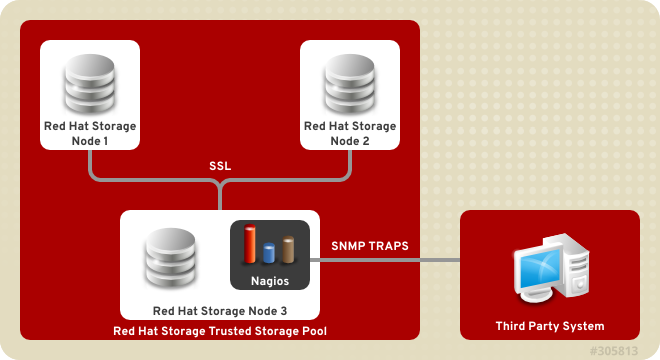Chapter 13. Monitoring Red Hat Storage
Monitoring of Red Hat Storage servers is built on Nagios platform to monitor Red Hat Storage trusted storage pool, hosts, volumes, and services. You can monitor utilization, status, alerts and notifications for status and utilization changes.
For more information on Nagios software, refer Nagios Documentation.
Using Nagios, the physical resources, logical resources, and processes (CPU, Memory, Disk, Network, Swap, cluster, volume, brick, Host, Volumes, Brick, nfs, shd, quotad, ctdb, smb, glusterd, quota, geo-replication, self-heal,and server quorum) can be monitored. You can view the utilization and status thorugh Nagios Server GUI.
Red Hat Storage trusted storage pool monitoring can be setup in one of the three deployment scenarios listed below:
- Nagios deployed on Red Hat Storage node.
- Nagios deployed on Red Hat Storage Console node.
- Nagios deployed on Red Hat Enterprise Linux node.
This chapter describes the procedures for deploying Nagios on Red Hat Storage node and Red Hat Enterprise Linux node. For information on deploying Nagios on Red Hat Storage Console node, see Red Hat Storage Console Administration Guide.
The following diagram illustrates deployment of Nagios on Red Hat Storage node.

Figure 13.1. Nagios deployed on Red Hat Storage node
The following diagram illustrates deployment of Nagios on Red Hat Enterprise Linux node.

Figure 13.2. Nagios deployed on Red Hat Enterprise Linux node
13.1. Prerequisites
Ensure that you register using Subscription Manager or Red Hat Network Classic (RHN) and enable the Nagios repositories before installing the Nagios Server.
Note
Register using Red Hat Network (RHN) Classic only if you are a Red Hat Satellite user.
- Registering using Subscription Manager and enabling Nagios repositories
- To install Nagios on Red Hat Storage node, subscribe to
rhs-nagios-3-for-rhel-6-server-rpmsrepository. - To install Nagios on Red Hat Enterprise Linux node, subscribe to
rhel-6-server-rpms,rhs-nagios-3-for-rhel-6-server-rpmsrepositories.
- Registering using Red Hat Network (RHN) Classic and subscribing to Nagios channels
- To install Nagios on Red Hat Storage node, subscribe to
rhel-x86_64-server-6-rhs-nagios-3channel. - To install Nagios on Red Hat Enterprise Linux node, subscribe to
rhel-x86_64-server-6,rhel-x86_64-server-6-rhs-nagios-3channels.
Important
Set SELinux to permissive on the node on which Nagios server is installed.